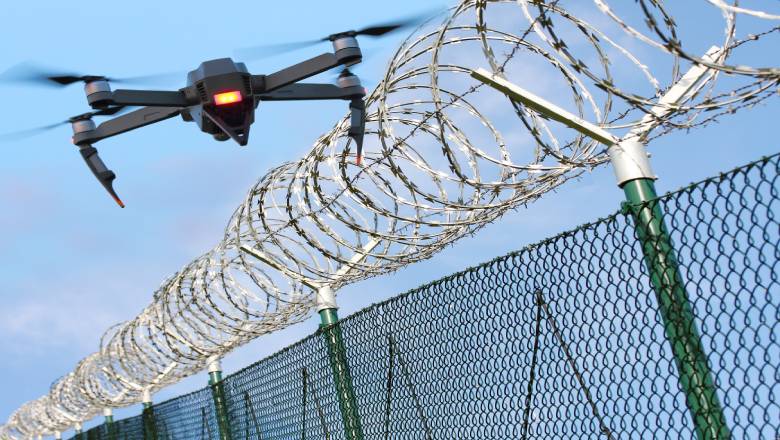
Predictive analysis
and the future of AI

Contrary to the popular narrative, Artificial Intelligence (AI) has been around for a long time in the security industry; it’s been embedded into our cameras since the 1980s. The first kind of video analytics was just a line on the screen and anything that crossed it would create an alert.
In the 2000s we started to see object recognition, facial recognition and behaviour recognition. In 2010 we started to see facial recognition bolstered by deep learning, the connection of smart devices like cameras, locks and sensors into integrated security systems. And now in the 2020s the current innovations focus on automation, end-to-end integration and making better use of data captured by AI and analytics.
From that early analytical trip wire we saw in the 1980s, AI-enabled cameras can now do so much more. There’s almost no limit to the amount of information that AI can deliver to us from a captured scene: if a vehicle is at a standstill or moving too fast, if someone has gone into a prohibited area or people are grouped together – it can even identify objects like guns and axes, detect body language and tell if someone is shouting.
One of AI’s greatest strengths is its ability to detect the presence of the abnormal or the absence of the normal but it is advancing all the time and its use is growing: according to the World Security Report, over the next five years, 42% of Chief Security Officers (CSOs) surveyed intend to invest in AI and AI-powered surveillance within their physical security operations. This investment is aimed at enabling physical security operations to react swiftly and accurately based on available data. AI, along with biometrics and facial recognition technology, is seen as top priorities for future investment. CSOs expect security providers to leverage data to generate insights that prevent security incidents.
I want to expand on how it can be used to great effect already in physical security and suggest what it might be able to do in the future.
Scalability
AI enhances our ability to detect threats through the continual, vigilant monitoring of security footage or data. It can do this at a much greater speed and scale than humans ever can – simply because it doesn’t need to sleep and won’t lose concentration. This allows for much larger volumes of information to be analysed with high accuracy.
AI scales well, whether it's running on an on-premise server network or in the cloud. Adding more cameras or other data sources does not necessarily require drastically more resources to compute like it would to hire more humans to monitor.
Automated systems like camera and sensor-equipped drones can expand coverage and access to remote physical areas, complementing ground-based sensors and security. Regulatory aspects around visual line of sight and autonomous drones are still evolving in certain countries, but AI-powered drone flight promises to be an exciting option for covering large areas.
Predictive analysis
The application of predictive analytics powered by AI is rapidly becoming an integral part of modern physical security solutions. Sophisticated machine learning algorithms can process volumes of data gathered by networks of cameras, access control systems, perimeter sensors and more. The goal is to identify patterns, anomalies and correlations that enable AI systems to forecast problems or threats before they occur
For instance, AI can continuously analyse video feeds to detect subtle anomalies in visitor or employee traffic flows compared to historical trends at a particular site. Unusual activity like accessing restricted areas or tailgating could trigger alerts, prompting a focused investigation. Over time, the system learns to automatically recognise authorised flows versus suspicious incidents worth escalating.
Other detection modes might analyse facility entry logs for spoofing attempts, assess raw guard tour data to recommend optimised patrol routes, or even scan social media to anticipate planned protests at sensitive locations.
AI has clear predictive advantages over legacy rules-based approaches. Machine learning allows today's platforms to model complex networks of conditions, adapting dynamically rather than relying on simplistic thresholds.
As a result, leading solutions now provide proactive forewarning of 10 to 60 minutes or more for threats ranging from unauthorised access to site protests, theft of goods, cyber intrusions and beyond. Continued improvements around detection accuracy, false alarm filtering and actionable incident workflow handling will be ongoing AI research focal points.
However, the enormous potential to anticipate problems before they manifest using AI predictive analytics is already bearing fruit across industries, from supply chains to healthcare. Physical security operations are now following suit in leveraging these cutting-edge capabilities as well.
Accuracy and detection
Looking ahead, contextual reasoning stands as a frontier for AI algorithms to further improve accuracy while reducing false positive alerts. With continued development, AI could understand permissible object possession based on location, time variables, authorised credentials and recognised intent. For example, differentiating a kitchen worker legitimately carrying knives versus a trespasser wielding a similar item as a probable threat.
Additionally, because AI retains consistent focus and operates by binary assessment of triggered observations rather than unpredictable human judgment, it serves to counterbalance the risk of decreased vigilance in humans over time due to complacency, overload and confirmation bias after excessive repetitive alerts.
The combination of human intelligence and optimised machine learning delivers the most accurate and reliable threat detection outcomes for now and the foreseeable future. With sustained technological progress, AI's performance will incrementally approach more dependable autonomous analytical capability - understanding proper contextual permission in parallel with human security personnel. But maximising this hybrid model focused on the unique strengths of both man and machine remains the wisest path forward.
Handling of mundane tasks
Looking forward, AI-enabled robots and drones equipped with multi-modal sensory technology offer new paradigms for supplementing boots-on-the-ground while collecting invaluable data. Whether rolling through warehouse aisles or soaring over remote sections of a pipeline, these machines handle monotonous inspection in environments dangerous or labour-intensive for security officers. Meanwhile, real-time location-indexed analytics get ingested for everything from inventory analytics to leakage detection to enhancing theft response.
The fusion of learned patterns with human flexibility allows for optimised resource allocation. People monitor the mission-critical encounters enabled by machines handling mundane but taxing tasks. This force multiplication equation yields expandable capacity improvements as AI offloads gruelling demands. Savvy deployment of assisted patrols and smart facility assistant bots will shed light on corners otherwise left unseen.
AI as a threat
We have already witnessed criminals fine-tuning AI to enhance social engineering, phishing attempts and identity theft in the digital realm. Physical protection must learn from these offensive advances – forged badges and faked biometric duplicates could be the next frontier if defences lag behind AI's creative potential.
This reality demands a balanced posture embracing AI’s strengths while mitigating vulnerabilities it may introduce. Companies would be wise to run through potential compromise scenarios leveraging AI prior to rollout, to uncover blind spots and create staff awareness about emerging high-tech deception tactics.
AI should never serve as a set-it-and-forget-it silver bullet but rather operate as an integrated component of defence-in-depth strategies. Thoughtful implementation combined with ongoing scrutiny of its security assumptions makes AI a powerful ally. Maintaining effective collaboration between people and technology in the face of rapidly evolving threats is essential for the coming age of AI-powered security.
